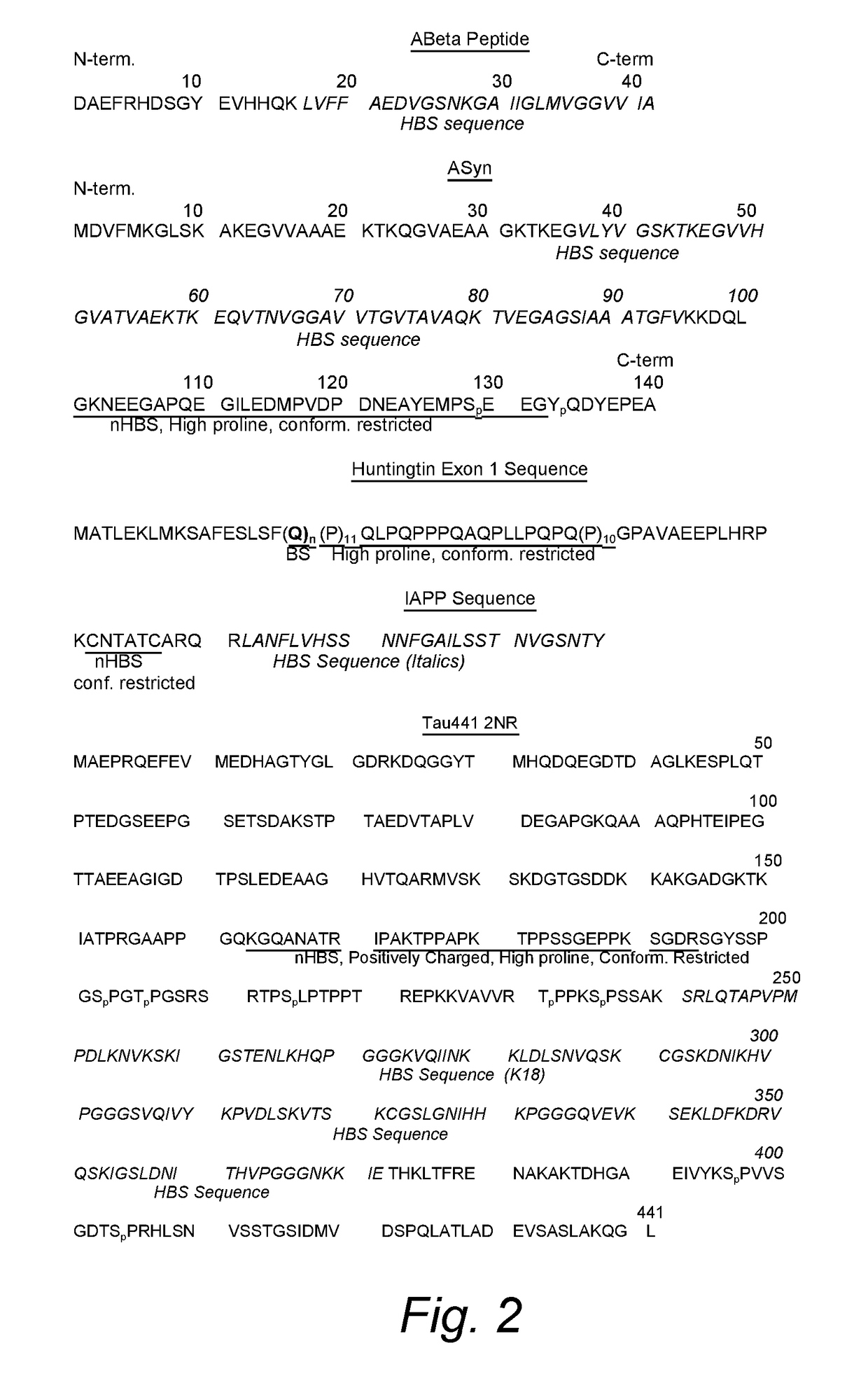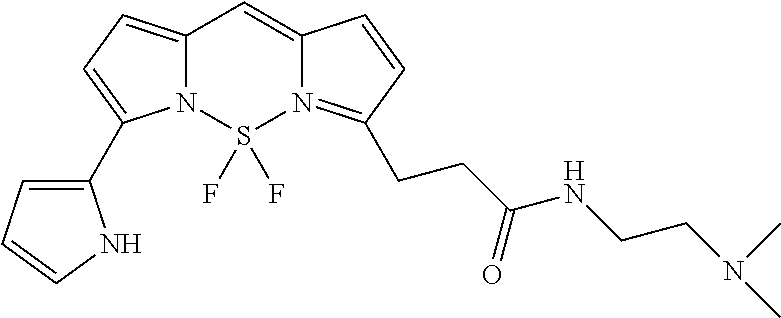Sequence Specific Fluorescence for Peptide-Fluorochrome Interactions
a fluorescence and peptide technology, applied in the field of sequence specific fluorescence of peptide-fluorochrome interactions, can solve the problems of limited selectivity of diagnostic or therapeutic drugs targeted to them, difficult development of asyn imaging agents with necessary selective asyn, and limited molecular specificity of therapeutic agents binding beta sheet targets, etc., to achieve the effect of reducing emission
- Summary
- Abstract
- Description
- Claims
- Application Information
AI Technical Summary
Benefits of technology
Problems solved by technology
Method used
Image
Examples
example 1
Method of Determining Sequence Specific Fluorochrome-Peptide Interactions Between a Fluorochrome and a Non-Hairpin Beta Sheet Peptide from ASyn.
[0058]Peptide(nHBS) is (NAc)GKNEEGAPQEGILEDMPVDPDNEAYEMPSEEG-NH2 (SEQ. ID No. 1), while Peptide(nHBS)scrm is (NAc)PGPNEKEVAEMQIDLEGDYDNEAEGSEMEPGP-NH2 (Seq. ID. No. 2). Peptide(nHBS) is amino acids 100-132 of human ASyn (FIG. 2) and consists of 10 negative amino acids (aspartate (D), and glutamate (E)) and one positive amino acid (lysine (K), so it is highly negatively charged. Peptide(nHBS) and Peptide(nHBS)scrm have identical amino acid compositions and negative charges but different sequences.
[0059]Each peptide (100 uL in PBS, at various concentrations) will be added to a test fluorochrome from a panel of test fluorochromes (100 uL in PBS) to a 96 well microtiter plate suitable determination of fluorescence using a microtiter plate reader. The concentration of test fluorochrome is between 1 and 1000 nM, preferably between about 5 and 50 n...
example 2
Method of Determining Sequence Specific Fluorochrome-Peptide Interactions Between a Fluorochrome and a Non Hairpin Beta Sheet Peptide from Tau.
[0066]The amino acids 163 to 195 of Tau441R are nHBS, are proline rich, and have a net positive charge, see FIG. 2. In this case, the Peptide(nHBS) is KGQANATRIPAKTPPAPKTPPSSGEPPKSGDR (Seq. ID. No. 3). The peptide has six positively charged lysine groups (K) plus arginines (R) and one negatively charged glutamate (E), for net positive charge. A scrambled nHBSscr peptide is also synthesized. A negatively charged panel of commercially available, negatively charged fluorochromes is used. The procedure from Example 1 is followed to select a Fluor(nHBS) that shows greater fluorescence with Peptide(nHBS) than Peptide(nHBS)scrm. Fluorescence measurements performed as in Example 1 are followed to determine fluorochrome binding to the Peptide(nHBS) in a sequence dependent fashion.
[0067]Since this peptide is positively charged, a panel of negatively ch...
example 3
Method of Determining Sequence Specific Fluorochrome-Peptide Interaction by Fluorescence Resonance Energy Transfer (FRET), Indicating
[0068]Fluorescence measurements using a fluorescence resonance energy transfer (FRET) donor / acceptor pair are employed to determine sequence dependent Fluoro(nHBS) / Peptide(nHBS) interactions, and their inhibition by a test compound. FRET occurs when there is spectral overlap between the emission spectrum of one fluorochrome and excitation spectrum of a second fluorochrome, and when the two fluorochromes are close to each other, generally less than about 10 nm. For FRET there are two fluorochromes, one of which (e.g. a donor) is covalently attached both to the peptide and to the scrambled peptide). A test fluorochrome (an acceptor) can bind to the peptide (in a sequence dependent fashion). When such binding occurs, energy transfer can occur between the two fluorochromes. If energy transfer does not occur with donor-fluorochrome-scrambled peptide, the in...
PUM
 Login to View More
Login to View More Abstract
Description
Claims
Application Information
 Login to View More
Login to View More - R&D
- Intellectual Property
- Life Sciences
- Materials
- Tech Scout
- Unparalleled Data Quality
- Higher Quality Content
- 60% Fewer Hallucinations
Browse by: Latest US Patents, China's latest patents, Technical Efficacy Thesaurus, Application Domain, Technology Topic, Popular Technical Reports.
© 2025 PatSnap. All rights reserved.Legal|Privacy policy|Modern Slavery Act Transparency Statement|Sitemap|About US| Contact US: help@patsnap.com



